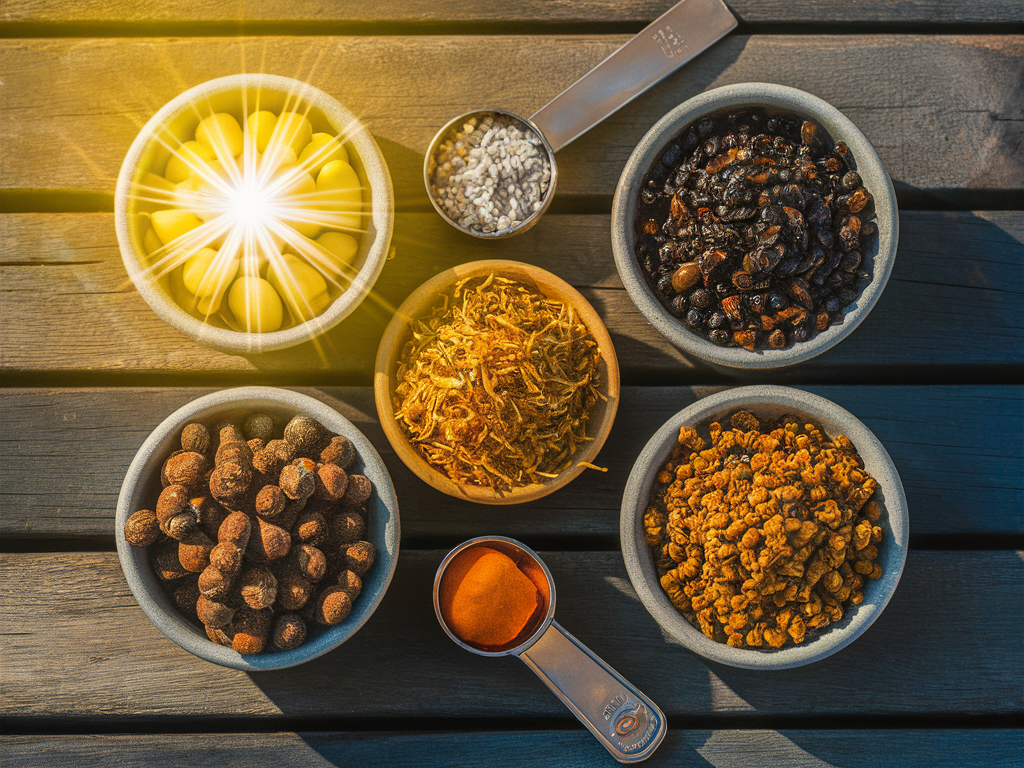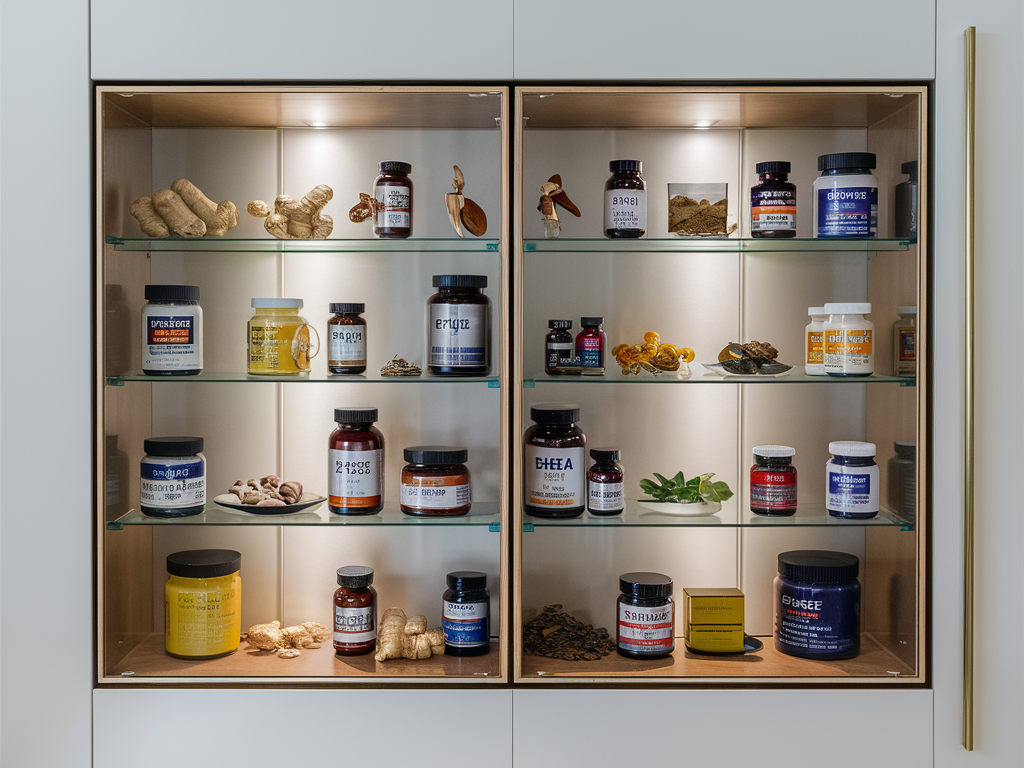Testosterone, the primary male sex hormone, plays a crucial role in men’s health, affecting everything from muscle mass and strength to energy levels, libido, and overall well-being. Unfortunately, testosterone levels have been declining in modern men due to various factors including poor diet, sedentary lifestyles, environmental toxins, and stress.
While synthetic testosterone replacement therapy is available, many men prefer natural alternatives due to potential side effects associated with synthetic options. This comprehensive guide explores science-backed natural testosterone boosters that can help restore optimal hormone levels without harmful side effects.
Our selection criteria focused on scientific evidence, effectiveness, safety profiles, and user experiences to bring you only the most reliable options available in 2024.

1. Vitamin D
Often called the “sunshine vitamin,” vitamin D functions more like a hormone than a typical vitamin in the body. Research has established a strong connection between vitamin D deficiency and suboptimal testosterone levels.
A randomized controlled trial published in the Journal of Clinical Endocrinology found that men who supplemented with vitamin D for one year experienced a significant 25.2% increase in total testosterone levels compared to the placebo group. Another study showed that men with sufficient vitamin D levels had significantly higher testosterone concentrations than those who were deficient.
Recommended dosage: 1,000-5,000 IU daily, depending on baseline levels and sun exposure. The best natural source is sunlight (15-20 minutes of direct exposure several times weekly), while fatty fish, egg yolks, and fortified foods provide dietary sources. For supplementation, vitamin D3 (cholecalciferol) is preferred over D2 for better absorption.
Expected benefits: Beyond testosterone optimization, adequate vitamin D supports bone health, immune function, and mood regulation. Most men notice improvements within 2-3 months of correcting deficiency.
2. Ashwagandha
Ashwagandha (Withania somnifera) is an adaptogenic herb with a 3,000-year history in Ayurvedic medicine. Its remarkable ability to reduce cortisol (the stress hormone) makes it particularly valuable for testosterone production.
A gold-standard study published in the American Journal of Men’s Health demonstrated that men taking ashwagandha extract for 8 weeks experienced a 14.7% greater increase in testosterone compared to placebo. The most impressive results occur in chronically stressed individuals, as cortisol and testosterone have an inverse relationship.
The primary mechanism involves ashwagandha’s cortisol-lowering properties, which creates a more favorable hormonal environment for testosterone synthesis. Additional benefits include improved sperm quality, enhanced recovery from exercise, and better stress resilience.
Dosage recommendations: 300-600mg of root extract standardized to contain 5% withanolides, taken daily. Some studies suggest cycling (8 weeks on, 2 weeks off) for optimal results.
Potential side effects: Generally well-tolerated, though mild digestive discomfort may occur initially. Those with autoimmune conditions should consult healthcare providers before use.
3. Zinc
Zinc is an essential mineral that serves as a crucial building block for testosterone production. This trace element acts as a cofactor for multiple enzymes involved in the testosterone synthesis pathway and helps regulate the conversion of androstenedione to testosterone.
Research published in Nutrition demonstrated that zinc supplementation in marginally zinc-deficient men increased serum testosterone from 8.3 to 16.0 nmol/L within six months. Interestingly, zinc becomes even more critical for athletes and men who exercise frequently, as intense physical activity depletes zinc stores more rapidly.
Signs of zinc deficiency include reduced sense of taste/smell, slow wound healing, frequent infections, and unexplained fatigue – all potential indicators of suboptimal testosterone levels.
Food sources high in zinc: Oysters (the richest natural source), grass-fed beef, pumpkin seeds, crab, lobster, and egg yolks.
Supplement recommendations: 25-30mg daily, preferably zinc picolinate or zinc glycinate for superior absorption. Taking zinc with meals containing protein enhances uptake, while excess calcium and phytates (found in some plant foods) can inhibit absorption.
4. D-Aspartic Acid
D-Aspartic Acid (D-AA) is an amino acid regulator of testosterone synthesis that works in the central brain region and testes. It stimulates the release of luteinizing hormone (LH), follicle-stimulating hormone (FSH), and growth hormone – all key players in testosterone production.
A landmark study published in Reproductive Biology and Endocrinology found that men supplementing with D-AA for just 12 days experienced a 42% increase in testosterone levels. However, subsequent research suggests these dramatic effects may be most pronounced in men with lower baseline testosterone or fertility issues.

Ideal candidates include men with documented low testosterone, those experiencing fertility challenges, or athletes during intensive training phases. Healthy men with normal testosterone levels may see less dramatic results.
Dosage protocol: 2,000-3,000mg daily, preferably taken with breakfast to maximize uptake. Cycling is recommended (2-3 weeks on, 1 week off) as continuous use may lead to diminishing returns.
5. Fenugreek
Fenugreek (Trigonella foenum-graecum) has been used for centuries in traditional medicine systems across India and the Middle East. Its modern application as a testosterone booster is supported by several clinical trials.
Research published in Phytotherapy Research demonstrated that men taking fenugreek extract for 12 weeks experienced significant improvements in testosterone levels, sexual function, and body composition compared to placebo. The unique mechanism of fenugreek involves inhibiting the enzymes that convert testosterone to estrogen and DHT, effectively preserving free testosterone levels.
Unlike some testosterone boosters that increase DHT (which can accelerate hair loss in genetically susceptible men), fenugreek may actually help maintain a healthier testosterone:DHT ratio while keeping estrogen in check.
Recommended forms and dosages: 500-600mg of standardized extract containing 50% fenuside glycosides daily. Whole fenugreek seeds (soaked or sprouted) can be included in the diet, though the concentrated extract provides more reliable hormonal benefits.
6. Magnesium
Magnesium is a fundamental mineral involved in over 300 enzymatic reactions in the body, including those that regulate hormonal balance. Research has established a direct relationship between magnesium levels and both total and free testosterone.
A study in Biological Trace Element Research found that athletes supplementing with magnesium experienced significant increases in free and total testosterone levels at rest and after exercise. Even more revealing, the effect was proportional to baseline deficiency – the more deficient, the greater the hormonal response to supplementation.
Signs of magnesium deficiency in men include muscle cramps, irritability, poor sleep quality, and decreased exercise performance – all of which can compound testosterone-related issues.
Food sources: Dark leafy greens, pumpkin seeds, almonds, dark chocolate, avocados, and black beans.
Supplement options: Magnesium glycinate, magnesium threonate, or magnesium citrate at 200-400mg daily, divided into two doses. Avoid magnesium oxide due to poor bioavailability.
Optimal timing: Taking magnesium in the evening can enhance sleep quality, which itself supports optimal testosterone production during the night.
7. DHEA
Dehydroepiandrosterone (DHEA) is a hormone produced by the adrenal glands that serves as a precursor to both testosterone and estrogen. Natural DHEA levels peak in early adulthood and decline steadily with age, falling to approximately 20% of peak levels by age 70.
Clinical research in the Journal of Clinical Endocrinology and Metabolism demonstrated that DHEA supplementation in aging men could increase bioavailable testosterone and improve body composition. Another study showed benefits for middle-aged men with partial androgen deficiency.
DHEA works as a direct precursor in the steroidogenic pathway, providing the raw material from which the body can synthesize testosterone. This makes it particularly valuable for men over 40 experiencing age-related hormonal decline.
Proper usage: 25-50mg daily for men over 40, preferably taken in the morning. Lower doses are recommended initially to assess tolerance.
Precautions: DHEA may affect hormone-sensitive conditions and can increase estrogen alongside testosterone in some individuals. Regular blood work is advised when supplementing long-term.
8. Tribulus Terrestris
Tribulus Terrestris has been used in traditional Chinese medicine, Ayurveda, and by Eastern European Olympic athletes for decades. While earlier research showed mixed results regarding direct testosterone increases, more recent studies have clarified its benefits.
Research published in Andrologia found that Tribulus supplementation improved sexual function and satisfaction in men with mild to moderate erectile dysfunction. Another study demonstrated benefits for libido and sexual wellbeing, potentially through optimizing androgen receptor sensitivity rather than dramatically increasing testosterone production.
The most promising applications for Tribulus include supporting libido, sexual performance, and fertility rather than driving substantial increases in serum testosterone. The active compounds (protodioscin and other saponins) may enhance the body’s response to existing testosterone rather than increasing baseline levels.
Recommended protocols: 500-750mg of extract standardized to contain 45-60% saponins and at least 20% protodioscin. Quality considerations are paramount with Tribulus, as many inferior products contain inadequate active compound concentrations.

9. Ginger
Ginger (Zingiber officinale) might seem like an unlikely testosterone booster, but research has validated its surprising hormonal benefits. This common culinary spice contains powerful bioactive compounds that support male reproductive health.
A study published in Tikrit Medical Journal found that ginger supplementation increased testosterone levels by 17.7% in infertile men after just three months. Another research paper in the International Journal of Reproductive BioMedicine showed improvements in sperm parameters and reproductive hormone profiles following ginger treatment.
The mechanisms behind ginger’s testosterone-boosting effects include its potent antioxidant properties, which protect Leydig cells (testosterone producers in the testes) from oxidative damage. Additionally, ginger appears to optimize the hypothalamic-pituitary-gonadal axis that regulates testosterone production.
Ways to incorporate ginger: Fresh ginger root (1-2 inches daily, added to smoothies, stir-fries, or tea), dried ginger powder (1 teaspoon daily), or supplements (1000-1500mg of standardized extract).
10. Exercise and Lifestyle Factors
While supplements can provide targeted support, exercise and lifestyle modifications offer the foundation for optimal testosterone production.
Resistance training has been consistently shown to elevate testosterone levels both acutely and chronically. Research in the European Journal of Applied Physiology found that compound exercises involving large muscle groups (squats, deadlifts, bench press) produced the greatest hormonal response. The optimal protocol appears to be moderate to heavy weights (70-85% of 1RM) with moderate volume (3-4 sets of 6-10 reps) and adequate rest periods (60-90 seconds).
Sleep quality is perhaps the most underappreciated factor in testosterone production. A study in the Journal of the American Medical Association demonstrated that restricting sleep to 5 hours per night for one week reduced daytime testosterone levels by 10-15% in healthy young men. Prioritizing 7-9 hours of quality sleep creates the optimal environment for overnight testosterone synthesis.
Stress management is crucial because chronic elevation of cortisol creates a catabolic environment that suppresses testosterone. Effective techniques include mindfulness meditation, deep breathing exercises, time in nature, and maintaining healthy social connections.
Dietary patterns that support optimal testosterone include:
- Adequate healthy fats (especially monounsaturated and saturated fats) at 25-35% of total calories
- Sufficient protein (1.6-2.2g per kg of bodyweight)
- Strategic carbohydrate intake around exercise
- Minimizing processed foods, excessive alcohol, and environmental endocrine disruptors
Conclusion
The most effective natural testosterone optimization strategy combines targeted supplementation with foundational lifestyle practices. For men seeking the greatest impact, prioritize vitamin D, zinc, magnesium, and ashwagandha as core supplements while implementing resistance training, quality sleep, stress management, and proper nutrition.
Many of these nutrients and compounds work synergistically – for example, vitamin D and zinc are both required for optimal testosterone synthesis, while ashwagandha and magnesium help reduce stress hormones that would otherwise suppress testosterone production.
Consistency is paramount when using natural approaches. Unlike synthetic testosterone which can produce rapid changes, natural methods typically require 2-3 months of consistent implementation before significant results emerge. Track your progress through subjective metrics like energy, libido, recovery, and body composition changes rather than becoming fixated on specific testosterone numbers.
Consult with healthcare providers if you experience persistent symptoms of low testosterone despite implementing these strategies, or if you have underlying medical conditions that may affect hormonal health.
FAQs
Are natural testosterone boosters safe?
The options presented in this guide have strong safety profiles when used as directed. Unlike synthetic testosterone which can suppress natural production, these natural options support the body’s endogenous pathways. However, individuals with existing health conditions should consult healthcare providers before beginning any supplementation regimen.
How quickly will I notice results from natural testosterone boosters?
Initial benefits like improved energy and libido may appear within 2-3 weeks, but more substantial changes to body composition and strength typically require 2-3 months of consistent use. Hormonal optimization is a marathon, not a sprint.
Can women take testosterone boosters?
While women produce and require small amounts of testosterone, most testosterone-boosting supplements are formulated for male physiology. Women should consult healthcare providers before using these products, as hormonal balance requirements differ significantly between sexes.
Do I need to cycle natural testosterone boosters?
Some compounds like D-Aspartic Acid and DHEA benefit from cycling, while others like vitamin D, zinc, and magnesium can be taken continuously. The article provides specific cycling recommendations for each supplement where applicable.
How can I tell if my testosterone levels are low?
Common symptoms include fatigue, reduced libido, difficulty building muscle, increased body fat (especially around the midsection), mood changes, and reduced motivation. While these symptoms can have multiple causes, they warrant investigation, ideally through blood testing in consultation with a healthcare provider.

